The Impact of E-Banking on Customer Satisfaction and Loyalty in the UK
VerifiedAdded on 2022/09/07
|18
|3915
|75
Report
AI Summary
This report investigates the significant impact of e-banking on customer satisfaction and loyalty within the United Kingdom's financial sector. It begins with an introduction highlighting the evolution of e-banking and its importance in today's competitive global market, emphasizing the positive relationship between customer satisfaction and loyalty. The report outlines the aims and objectives, which include analyzing how e-banking enhances customer satisfaction. A comprehensive literature review provides background information on the UK banking industry, e-business models, and a detailed comparison between e-banking and traditional banking systems, focusing on convenience, cost, and security. The methodology section details the use of semi-structured questionnaires, ethical considerations, and sample selection for data collection. The report also covers data analytical tools and a proposed timeline for the study's completion, supporting the importance of e-banking in today's modern banking system. The findings underscore the increasing acceptance of online banking and its positive effect on customer experience and loyalty, which is vital for any organization's survival.
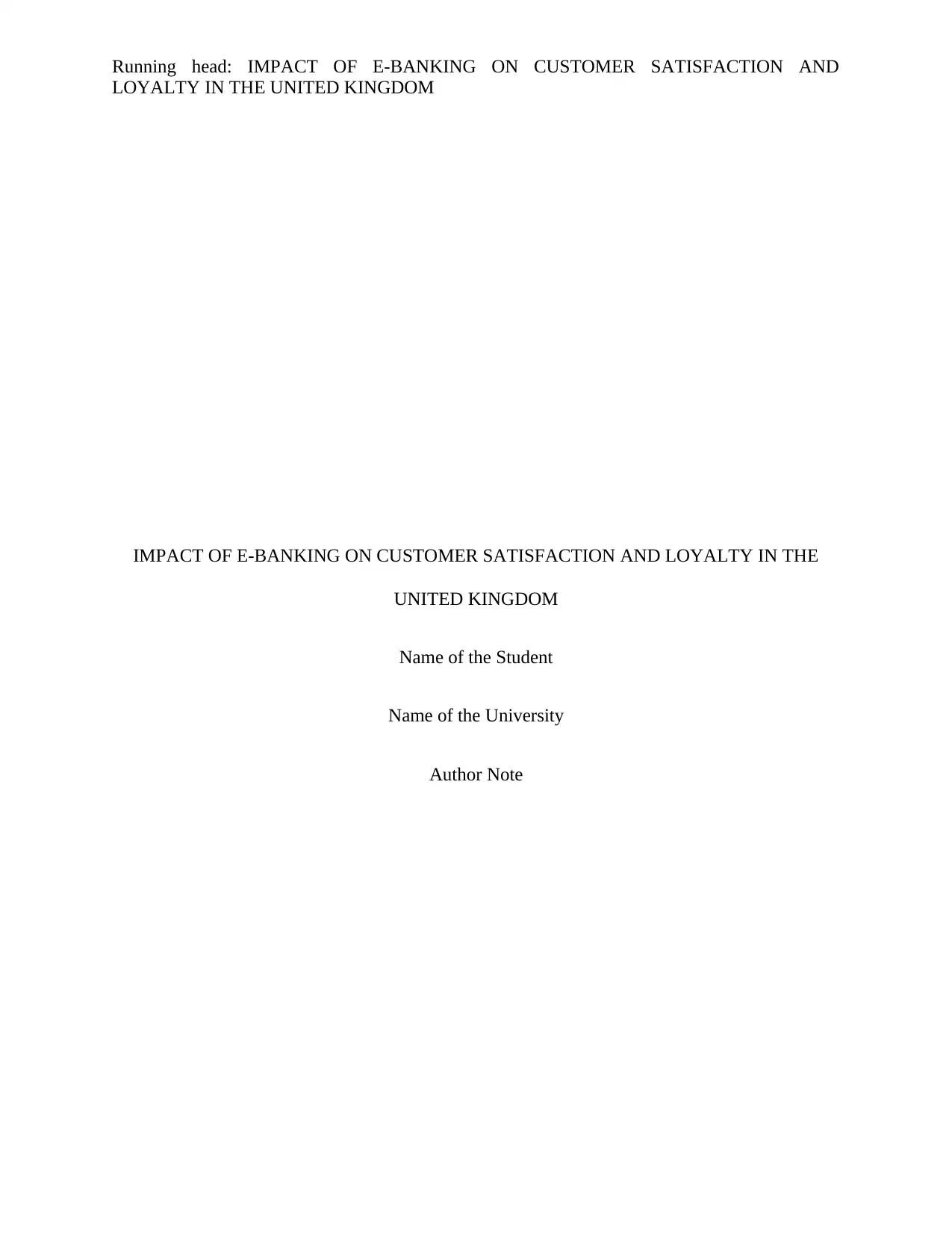
Running head: IMPACT OF E-BANKING ON CUSTOMER SATISFACTION AND
LOYALTY IN THE UNITED KINGDOM
IMPACT OF E-BANKING ON CUSTOMER SATISFACTION AND LOYALTY IN THE
UNITED KINGDOM
Name of the Student
Name of the University
Author Note
LOYALTY IN THE UNITED KINGDOM
IMPACT OF E-BANKING ON CUSTOMER SATISFACTION AND LOYALTY IN THE
UNITED KINGDOM
Name of the Student
Name of the University
Author Note
Paraphrase This Document
Need a fresh take? Get an instant paraphrase of this document with our AI Paraphraser
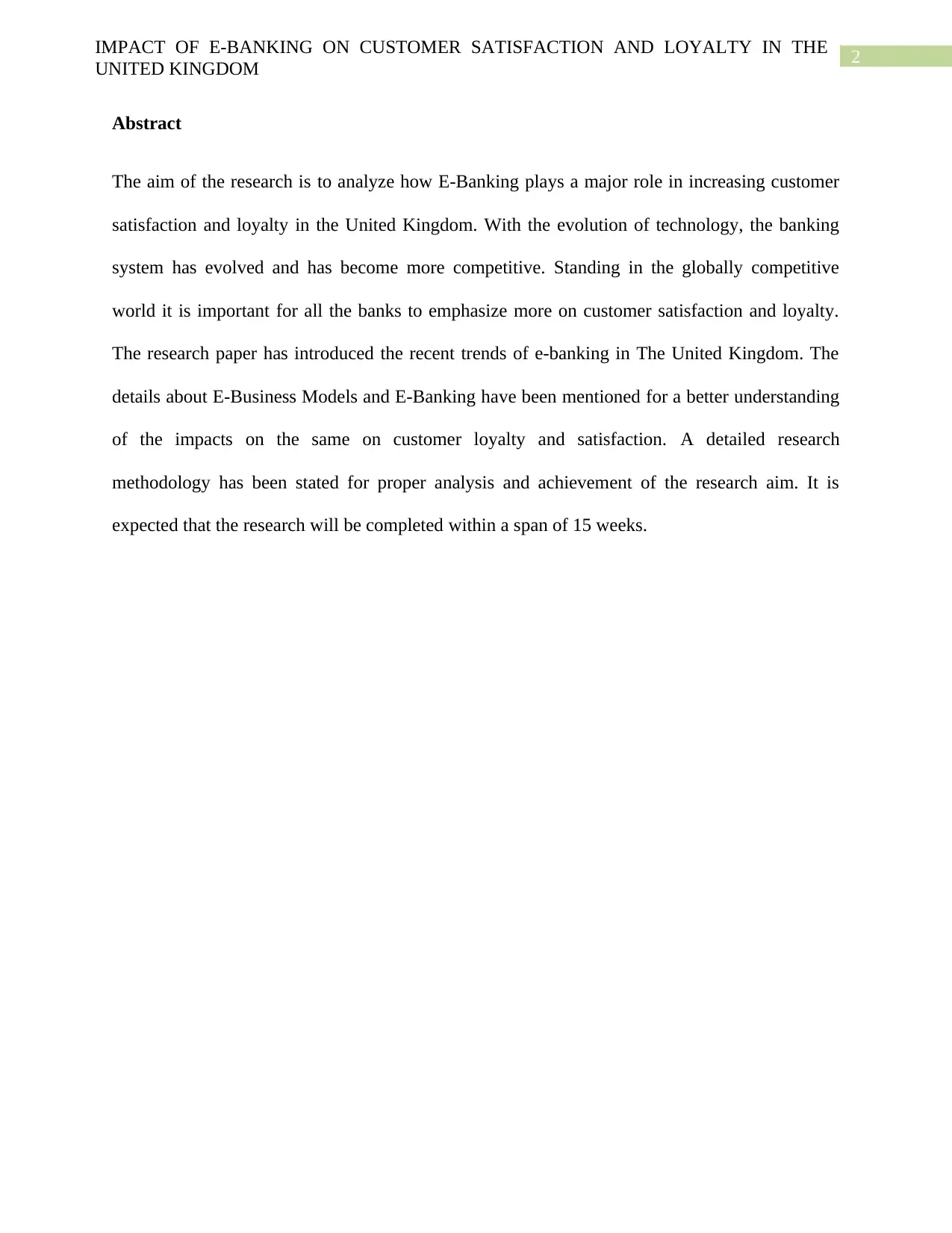
2IMPACT OF E-BANKING ON CUSTOMER SATISFACTION AND LOYALTY IN THE
UNITED KINGDOM
Abstract
The aim of the research is to analyze how E-Banking plays a major role in increasing customer
satisfaction and loyalty in the United Kingdom. With the evolution of technology, the banking
system has evolved and has become more competitive. Standing in the globally competitive
world it is important for all the banks to emphasize more on customer satisfaction and loyalty.
The research paper has introduced the recent trends of e-banking in The United Kingdom. The
details about E-Business Models and E-Banking have been mentioned for a better understanding
of the impacts on the same on customer loyalty and satisfaction. A detailed research
methodology has been stated for proper analysis and achievement of the research aim. It is
expected that the research will be completed within a span of 15 weeks.
UNITED KINGDOM
Abstract
The aim of the research is to analyze how E-Banking plays a major role in increasing customer
satisfaction and loyalty in the United Kingdom. With the evolution of technology, the banking
system has evolved and has become more competitive. Standing in the globally competitive
world it is important for all the banks to emphasize more on customer satisfaction and loyalty.
The research paper has introduced the recent trends of e-banking in The United Kingdom. The
details about E-Business Models and E-Banking have been mentioned for a better understanding
of the impacts on the same on customer loyalty and satisfaction. A detailed research
methodology has been stated for proper analysis and achievement of the research aim. It is
expected that the research will be completed within a span of 15 weeks.
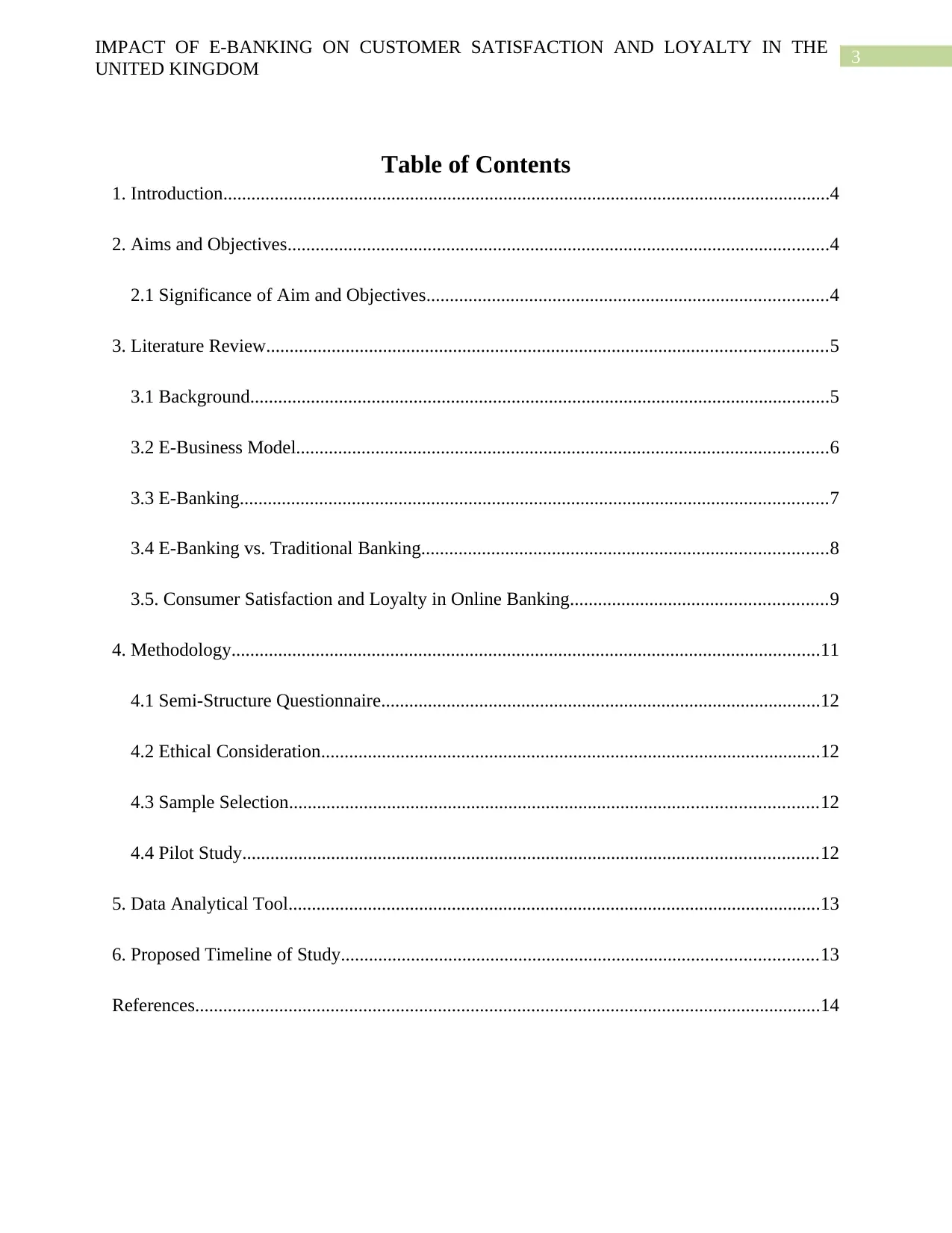
3IMPACT OF E-BANKING ON CUSTOMER SATISFACTION AND LOYALTY IN THE
UNITED KINGDOM
Table of Contents
1. Introduction..................................................................................................................................4
2. Aims and Objectives....................................................................................................................4
2.1 Significance of Aim and Objectives......................................................................................4
3. Literature Review........................................................................................................................5
3.1 Background............................................................................................................................5
3.2 E-Business Model..................................................................................................................6
3.3 E-Banking..............................................................................................................................7
3.4 E-Banking vs. Traditional Banking.......................................................................................8
3.5. Consumer Satisfaction and Loyalty in Online Banking.......................................................9
4. Methodology..............................................................................................................................11
4.1 Semi-Structure Questionnaire..............................................................................................12
4.2 Ethical Consideration...........................................................................................................12
4.3 Sample Selection.................................................................................................................12
4.4 Pilot Study...........................................................................................................................12
5. Data Analytical Tool..................................................................................................................13
6. Proposed Timeline of Study......................................................................................................13
References......................................................................................................................................14
UNITED KINGDOM
Table of Contents
1. Introduction..................................................................................................................................4
2. Aims and Objectives....................................................................................................................4
2.1 Significance of Aim and Objectives......................................................................................4
3. Literature Review........................................................................................................................5
3.1 Background............................................................................................................................5
3.2 E-Business Model..................................................................................................................6
3.3 E-Banking..............................................................................................................................7
3.4 E-Banking vs. Traditional Banking.......................................................................................8
3.5. Consumer Satisfaction and Loyalty in Online Banking.......................................................9
4. Methodology..............................................................................................................................11
4.1 Semi-Structure Questionnaire..............................................................................................12
4.2 Ethical Consideration...........................................................................................................12
4.3 Sample Selection.................................................................................................................12
4.4 Pilot Study...........................................................................................................................12
5. Data Analytical Tool..................................................................................................................13
6. Proposed Timeline of Study......................................................................................................13
References......................................................................................................................................14
⊘ This is a preview!⊘
Do you want full access?
Subscribe today to unlock all pages.

Trusted by 1+ million students worldwide

4IMPACT OF E-BANKING ON CUSTOMER SATISFACTION AND LOYALTY IN THE
UNITED KINGDOM
UNITED KINGDOM
Paraphrase This Document
Need a fresh take? Get an instant paraphrase of this document with our AI Paraphraser
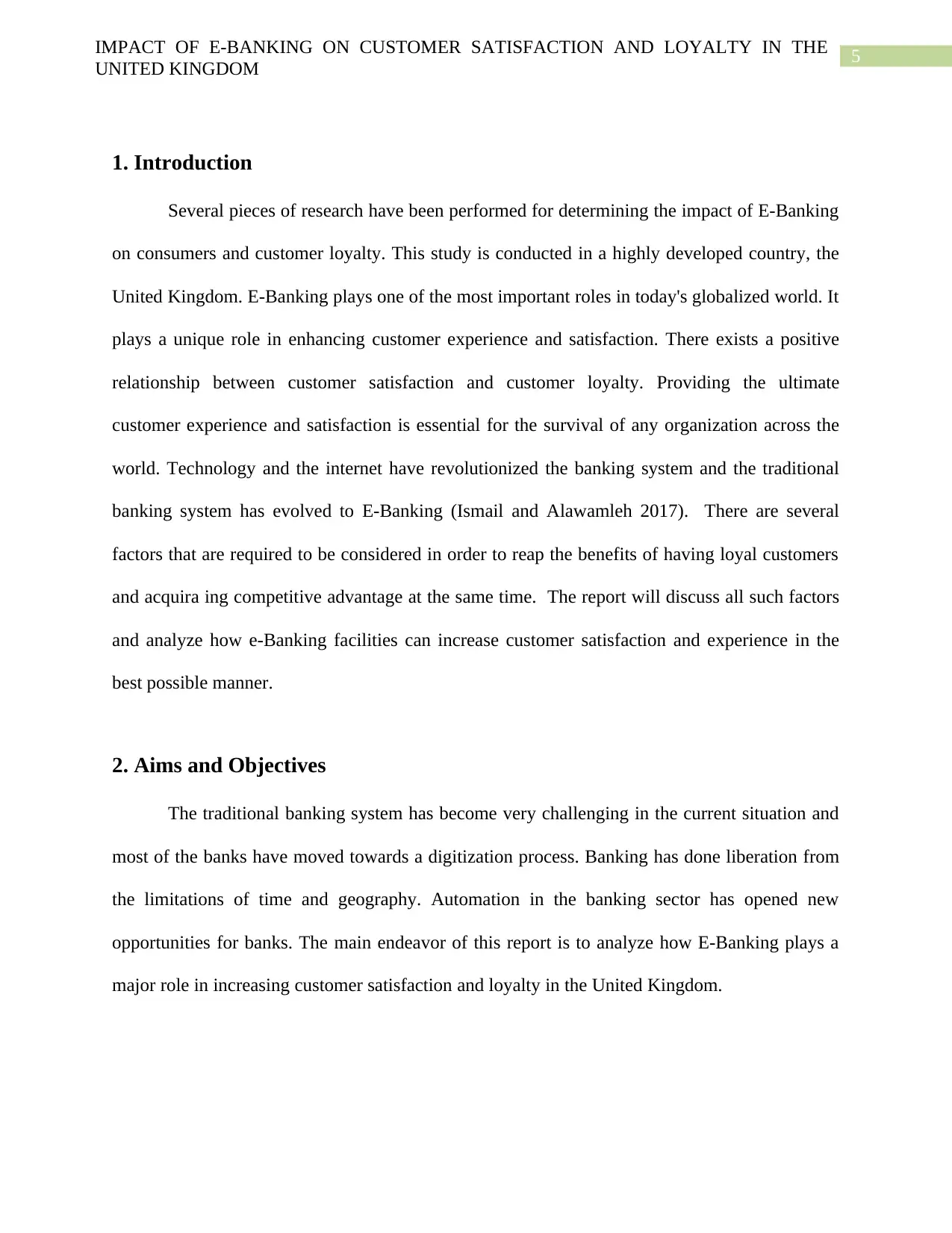
5IMPACT OF E-BANKING ON CUSTOMER SATISFACTION AND LOYALTY IN THE
UNITED KINGDOM
1. Introduction
Several pieces of research have been performed for determining the impact of E-Banking
on consumers and customer loyalty. This study is conducted in a highly developed country, the
United Kingdom. E-Banking plays one of the most important roles in today's globalized world. It
plays a unique role in enhancing customer experience and satisfaction. There exists a positive
relationship between customer satisfaction and customer loyalty. Providing the ultimate
customer experience and satisfaction is essential for the survival of any organization across the
world. Technology and the internet have revolutionized the banking system and the traditional
banking system has evolved to E-Banking (Ismail and Alawamleh 2017). There are several
factors that are required to be considered in order to reap the benefits of having loyal customers
and acquira ing competitive advantage at the same time. The report will discuss all such factors
and analyze how e-Banking facilities can increase customer satisfaction and experience in the
best possible manner.
2. Aims and Objectives
The traditional banking system has become very challenging in the current situation and
most of the banks have moved towards a digitization process. Banking has done liberation from
the limitations of time and geography. Automation in the banking sector has opened new
opportunities for banks. The main endeavor of this report is to analyze how E-Banking plays a
major role in increasing customer satisfaction and loyalty in the United Kingdom.
UNITED KINGDOM
1. Introduction
Several pieces of research have been performed for determining the impact of E-Banking
on consumers and customer loyalty. This study is conducted in a highly developed country, the
United Kingdom. E-Banking plays one of the most important roles in today's globalized world. It
plays a unique role in enhancing customer experience and satisfaction. There exists a positive
relationship between customer satisfaction and customer loyalty. Providing the ultimate
customer experience and satisfaction is essential for the survival of any organization across the
world. Technology and the internet have revolutionized the banking system and the traditional
banking system has evolved to E-Banking (Ismail and Alawamleh 2017). There are several
factors that are required to be considered in order to reap the benefits of having loyal customers
and acquira ing competitive advantage at the same time. The report will discuss all such factors
and analyze how e-Banking facilities can increase customer satisfaction and experience in the
best possible manner.
2. Aims and Objectives
The traditional banking system has become very challenging in the current situation and
most of the banks have moved towards a digitization process. Banking has done liberation from
the limitations of time and geography. Automation in the banking sector has opened new
opportunities for banks. The main endeavor of this report is to analyze how E-Banking plays a
major role in increasing customer satisfaction and loyalty in the United Kingdom.
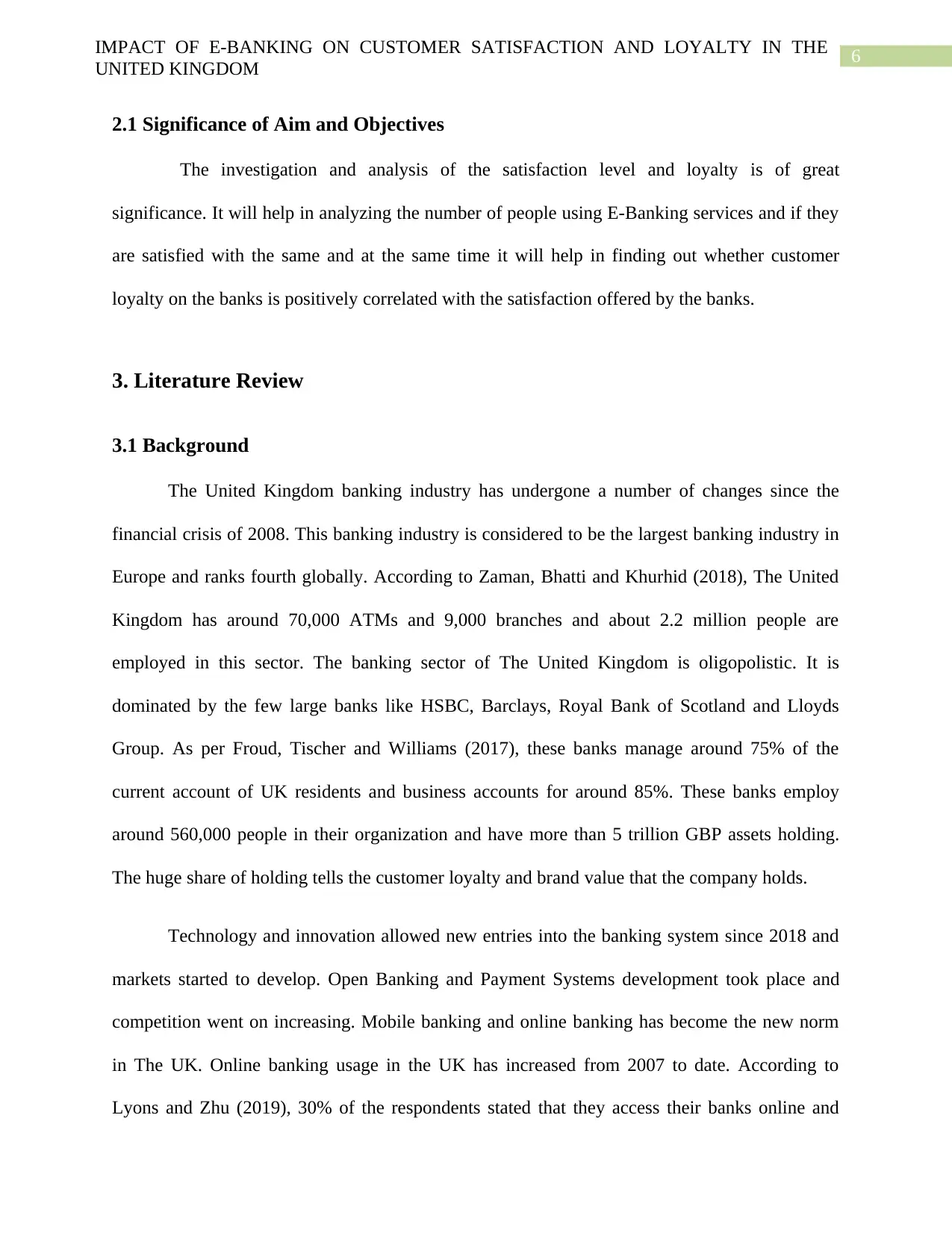
6IMPACT OF E-BANKING ON CUSTOMER SATISFACTION AND LOYALTY IN THE
UNITED KINGDOM
2.1 Significance of Aim and Objectives
The investigation and analysis of the satisfaction level and loyalty is of great
significance. It will help in analyzing the number of people using E-Banking services and if they
are satisfied with the same and at the same time it will help in finding out whether customer
loyalty on the banks is positively correlated with the satisfaction offered by the banks.
3. Literature Review
3.1 Background
The United Kingdom banking industry has undergone a number of changes since the
financial crisis of 2008. This banking industry is considered to be the largest banking industry in
Europe and ranks fourth globally. According to Zaman, Bhatti and Khurhid (2018), The United
Kingdom has around 70,000 ATMs and 9,000 branches and about 2.2 million people are
employed in this sector. The banking sector of The United Kingdom is oligopolistic. It is
dominated by the few large banks like HSBC, Barclays, Royal Bank of Scotland and Lloyds
Group. As per Froud, Tischer and Williams (2017), these banks manage around 75% of the
current account of UK residents and business accounts for around 85%. These banks employ
around 560,000 people in their organization and have more than 5 trillion GBP assets holding.
The huge share of holding tells the customer loyalty and brand value that the company holds.
Technology and innovation allowed new entries into the banking system since 2018 and
markets started to develop. Open Banking and Payment Systems development took place and
competition went on increasing. Mobile banking and online banking has become the new norm
in The UK. Online banking usage in the UK has increased from 2007 to date. According to
Lyons and Zhu (2019), 30% of the respondents stated that they access their banks online and
UNITED KINGDOM
2.1 Significance of Aim and Objectives
The investigation and analysis of the satisfaction level and loyalty is of great
significance. It will help in analyzing the number of people using E-Banking services and if they
are satisfied with the same and at the same time it will help in finding out whether customer
loyalty on the banks is positively correlated with the satisfaction offered by the banks.
3. Literature Review
3.1 Background
The United Kingdom banking industry has undergone a number of changes since the
financial crisis of 2008. This banking industry is considered to be the largest banking industry in
Europe and ranks fourth globally. According to Zaman, Bhatti and Khurhid (2018), The United
Kingdom has around 70,000 ATMs and 9,000 branches and about 2.2 million people are
employed in this sector. The banking sector of The United Kingdom is oligopolistic. It is
dominated by the few large banks like HSBC, Barclays, Royal Bank of Scotland and Lloyds
Group. As per Froud, Tischer and Williams (2017), these banks manage around 75% of the
current account of UK residents and business accounts for around 85%. These banks employ
around 560,000 people in their organization and have more than 5 trillion GBP assets holding.
The huge share of holding tells the customer loyalty and brand value that the company holds.
Technology and innovation allowed new entries into the banking system since 2018 and
markets started to develop. Open Banking and Payment Systems development took place and
competition went on increasing. Mobile banking and online banking has become the new norm
in The UK. Online banking usage in the UK has increased from 2007 to date. According to
Lyons and Zhu (2019), 30% of the respondents stated that they access their banks online and
⊘ This is a preview!⊘
Do you want full access?
Subscribe today to unlock all pages.

Trusted by 1+ million students worldwide
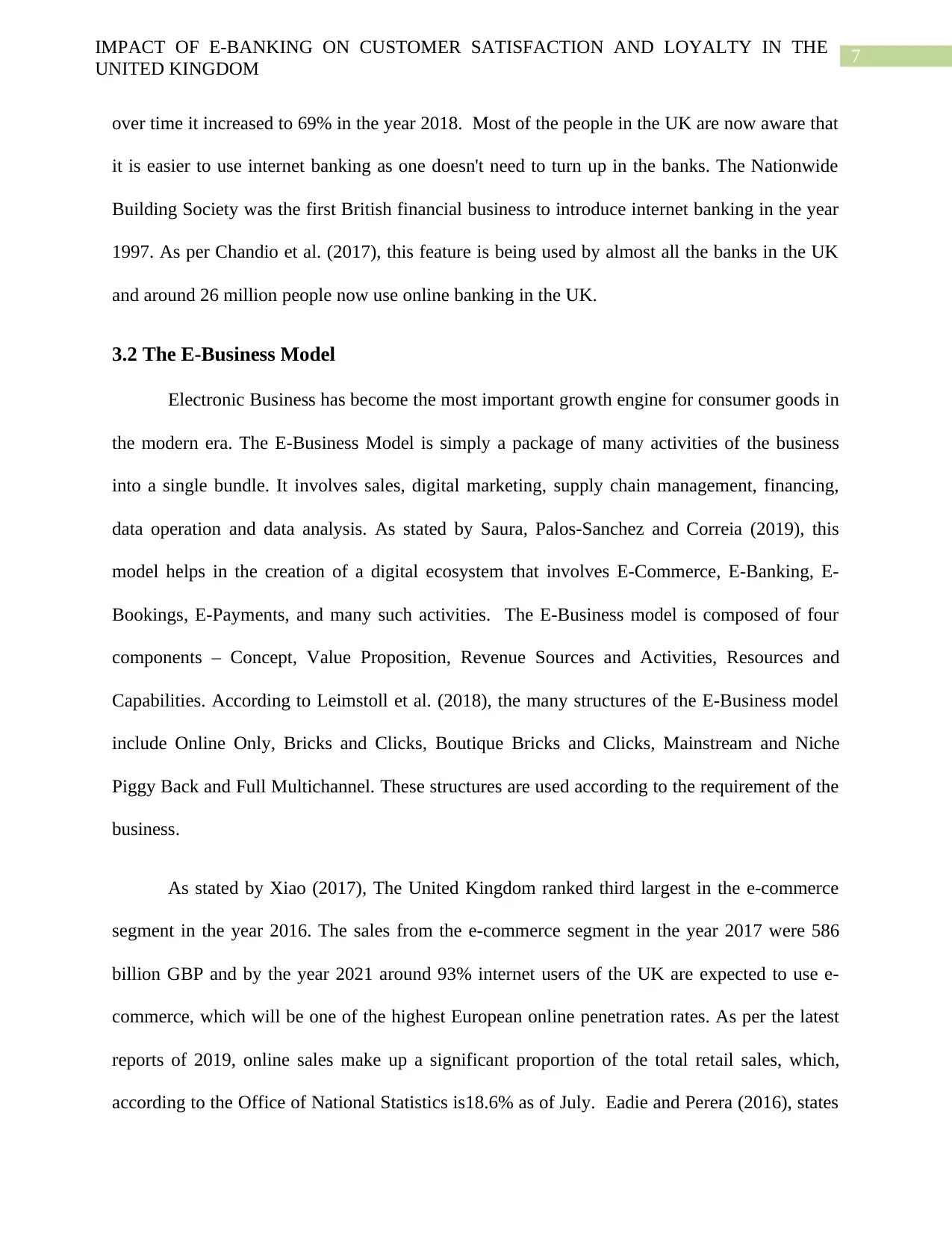
7IMPACT OF E-BANKING ON CUSTOMER SATISFACTION AND LOYALTY IN THE
UNITED KINGDOM
over time it increased to 69% in the year 2018. Most of the people in the UK are now aware that
it is easier to use internet banking as one doesn't need to turn up in the banks. The Nationwide
Building Society was the first British financial business to introduce internet banking in the year
1997. As per Chandio et al. (2017), this feature is being used by almost all the banks in the UK
and around 26 million people now use online banking in the UK.
3.2 The E-Business Model
Electronic Business has become the most important growth engine for consumer goods in
the modern era. The E-Business Model is simply a package of many activities of the business
into a single bundle. It involves sales, digital marketing, supply chain management, financing,
data operation and data analysis. As stated by Saura, Palos-Sanchez and Correia (2019), this
model helps in the creation of a digital ecosystem that involves E-Commerce, E-Banking, E-
Bookings, E-Payments, and many such activities. The E-Business model is composed of four
components – Concept, Value Proposition, Revenue Sources and Activities, Resources and
Capabilities. According to Leimstoll et al. (2018), the many structures of the E-Business model
include Online Only, Bricks and Clicks, Boutique Bricks and Clicks, Mainstream and Niche
Piggy Back and Full Multichannel. These structures are used according to the requirement of the
business.
As stated by Xiao (2017), The United Kingdom ranked third largest in the e-commerce
segment in the year 2016. The sales from the e-commerce segment in the year 2017 were 586
billion GBP and by the year 2021 around 93% internet users of the UK are expected to use e-
commerce, which will be one of the highest European online penetration rates. As per the latest
reports of 2019, online sales make up a significant proportion of the total retail sales, which,
according to the Office of National Statistics is18.6% as of July. Eadie and Perera (2016), states
UNITED KINGDOM
over time it increased to 69% in the year 2018. Most of the people in the UK are now aware that
it is easier to use internet banking as one doesn't need to turn up in the banks. The Nationwide
Building Society was the first British financial business to introduce internet banking in the year
1997. As per Chandio et al. (2017), this feature is being used by almost all the banks in the UK
and around 26 million people now use online banking in the UK.
3.2 The E-Business Model
Electronic Business has become the most important growth engine for consumer goods in
the modern era. The E-Business Model is simply a package of many activities of the business
into a single bundle. It involves sales, digital marketing, supply chain management, financing,
data operation and data analysis. As stated by Saura, Palos-Sanchez and Correia (2019), this
model helps in the creation of a digital ecosystem that involves E-Commerce, E-Banking, E-
Bookings, E-Payments, and many such activities. The E-Business model is composed of four
components – Concept, Value Proposition, Revenue Sources and Activities, Resources and
Capabilities. According to Leimstoll et al. (2018), the many structures of the E-Business model
include Online Only, Bricks and Clicks, Boutique Bricks and Clicks, Mainstream and Niche
Piggy Back and Full Multichannel. These structures are used according to the requirement of the
business.
As stated by Xiao (2017), The United Kingdom ranked third largest in the e-commerce
segment in the year 2016. The sales from the e-commerce segment in the year 2017 were 586
billion GBP and by the year 2021 around 93% internet users of the UK are expected to use e-
commerce, which will be one of the highest European online penetration rates. As per the latest
reports of 2019, online sales make up a significant proportion of the total retail sales, which,
according to the Office of National Statistics is18.6% as of July. Eadie and Perera (2016), states
Paraphrase This Document
Need a fresh take? Get an instant paraphrase of this document with our AI Paraphraser
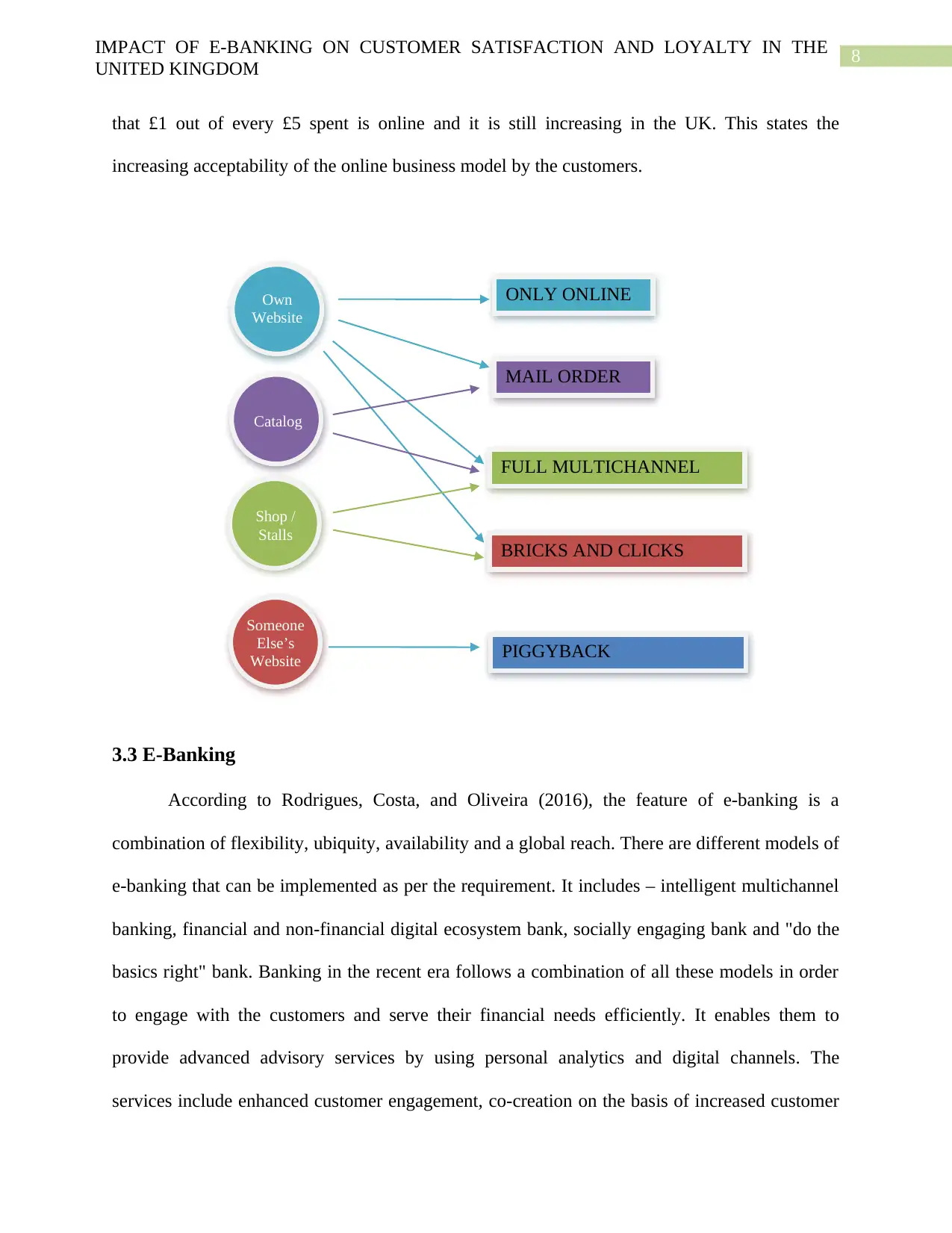
8IMPACT OF E-BANKING ON CUSTOMER SATISFACTION AND LOYALTY IN THE
UNITED KINGDOM
that £1 out of every £5 spent is online and it is still increasing in the UK. This states the
increasing acceptability of the online business model by the customers.
3.3 E-Banking
According to Rodrigues, Costa, and Oliveira (2016), the feature of e-banking is a
combination of flexibility, ubiquity, availability and a global reach. There are different models of
e-banking that can be implemented as per the requirement. It includes – intelligent multichannel
banking, financial and non-financial digital ecosystem bank, socially engaging bank and "do the
basics right" bank. Banking in the recent era follows a combination of all these models in order
to engage with the customers and serve their financial needs efficiently. It enables them to
provide advanced advisory services by using personal analytics and digital channels. The
services include enhanced customer engagement, co-creation on the basis of increased customer
ONLY ONLINE
MAIL ORDER
FULL MULTICHANNEL
BRICKS AND CLICKS
PIGGYBACK
Own
Website
Catalog
Shop /
Stalls
Someone
Else’s
Website
UNITED KINGDOM
that £1 out of every £5 spent is online and it is still increasing in the UK. This states the
increasing acceptability of the online business model by the customers.
3.3 E-Banking
According to Rodrigues, Costa, and Oliveira (2016), the feature of e-banking is a
combination of flexibility, ubiquity, availability and a global reach. There are different models of
e-banking that can be implemented as per the requirement. It includes – intelligent multichannel
banking, financial and non-financial digital ecosystem bank, socially engaging bank and "do the
basics right" bank. Banking in the recent era follows a combination of all these models in order
to engage with the customers and serve their financial needs efficiently. It enables them to
provide advanced advisory services by using personal analytics and digital channels. The
services include enhanced customer engagement, co-creation on the basis of increased customer
ONLY ONLINE
MAIL ORDER
FULL MULTICHANNEL
BRICKS AND CLICKS
PIGGYBACK
Own
Website
Catalog
Shop /
Stalls
Someone
Else’s
Website
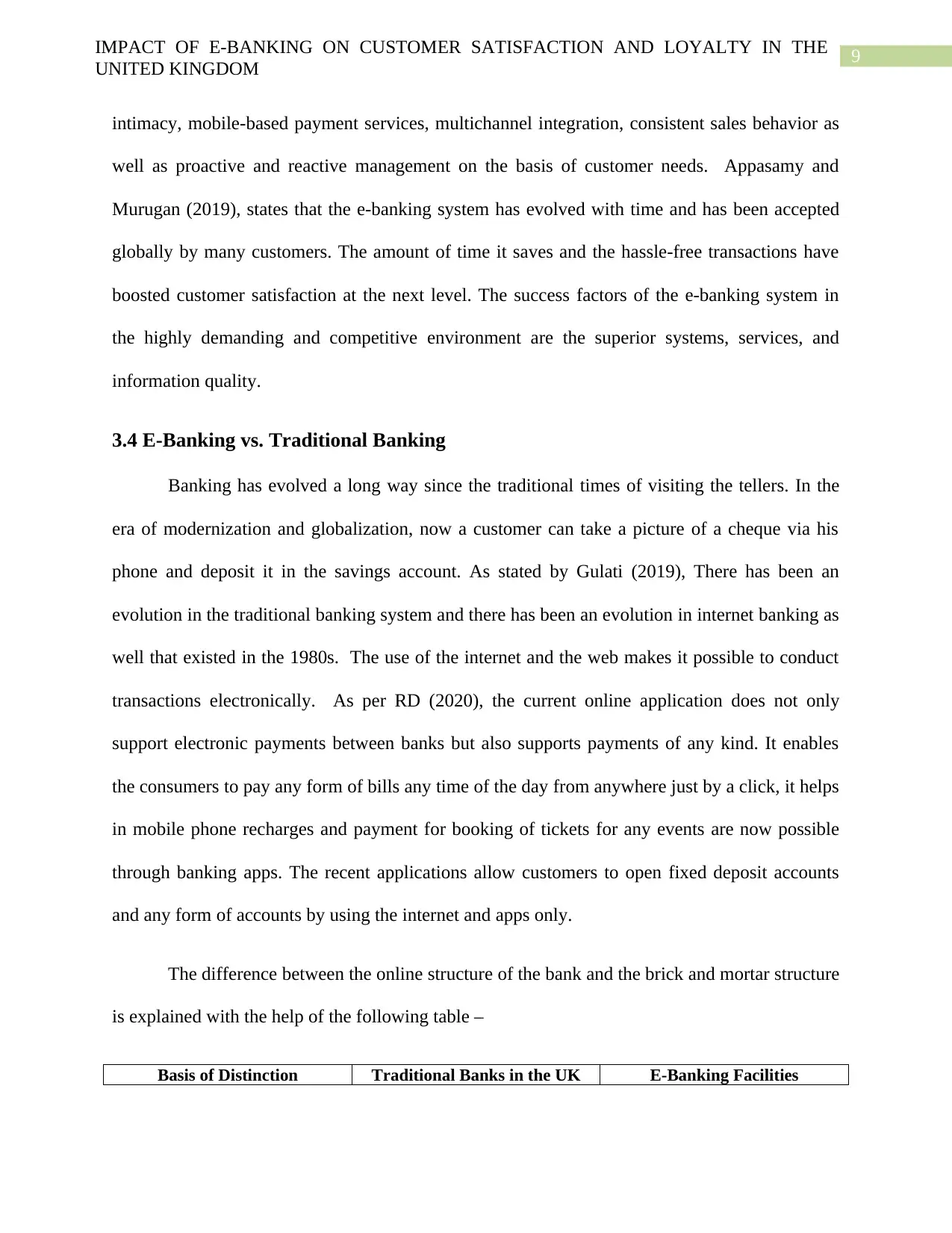
9IMPACT OF E-BANKING ON CUSTOMER SATISFACTION AND LOYALTY IN THE
UNITED KINGDOM
intimacy, mobile-based payment services, multichannel integration, consistent sales behavior as
well as proactive and reactive management on the basis of customer needs. Appasamy and
Murugan (2019), states that the e-banking system has evolved with time and has been accepted
globally by many customers. The amount of time it saves and the hassle-free transactions have
boosted customer satisfaction at the next level. The success factors of the e-banking system in
the highly demanding and competitive environment are the superior systems, services, and
information quality.
3.4 E-Banking vs. Traditional Banking
Banking has evolved a long way since the traditional times of visiting the tellers. In the
era of modernization and globalization, now a customer can take a picture of a cheque via his
phone and deposit it in the savings account. As stated by Gulati (2019), There has been an
evolution in the traditional banking system and there has been an evolution in internet banking as
well that existed in the 1980s. The use of the internet and the web makes it possible to conduct
transactions electronically. As per RD (2020), the current online application does not only
support electronic payments between banks but also supports payments of any kind. It enables
the consumers to pay any form of bills any time of the day from anywhere just by a click, it helps
in mobile phone recharges and payment for booking of tickets for any events are now possible
through banking apps. The recent applications allow customers to open fixed deposit accounts
and any form of accounts by using the internet and apps only.
The difference between the online structure of the bank and the brick and mortar structure
is explained with the help of the following table –
Basis of Distinction Traditional Banks in the UK E-Banking Facilities
UNITED KINGDOM
intimacy, mobile-based payment services, multichannel integration, consistent sales behavior as
well as proactive and reactive management on the basis of customer needs. Appasamy and
Murugan (2019), states that the e-banking system has evolved with time and has been accepted
globally by many customers. The amount of time it saves and the hassle-free transactions have
boosted customer satisfaction at the next level. The success factors of the e-banking system in
the highly demanding and competitive environment are the superior systems, services, and
information quality.
3.4 E-Banking vs. Traditional Banking
Banking has evolved a long way since the traditional times of visiting the tellers. In the
era of modernization and globalization, now a customer can take a picture of a cheque via his
phone and deposit it in the savings account. As stated by Gulati (2019), There has been an
evolution in the traditional banking system and there has been an evolution in internet banking as
well that existed in the 1980s. The use of the internet and the web makes it possible to conduct
transactions electronically. As per RD (2020), the current online application does not only
support electronic payments between banks but also supports payments of any kind. It enables
the consumers to pay any form of bills any time of the day from anywhere just by a click, it helps
in mobile phone recharges and payment for booking of tickets for any events are now possible
through banking apps. The recent applications allow customers to open fixed deposit accounts
and any form of accounts by using the internet and apps only.
The difference between the online structure of the bank and the brick and mortar structure
is explained with the help of the following table –
Basis of Distinction Traditional Banks in the UK E-Banking Facilities
⊘ This is a preview!⊘
Do you want full access?
Subscribe today to unlock all pages.

Trusted by 1+ million students worldwide
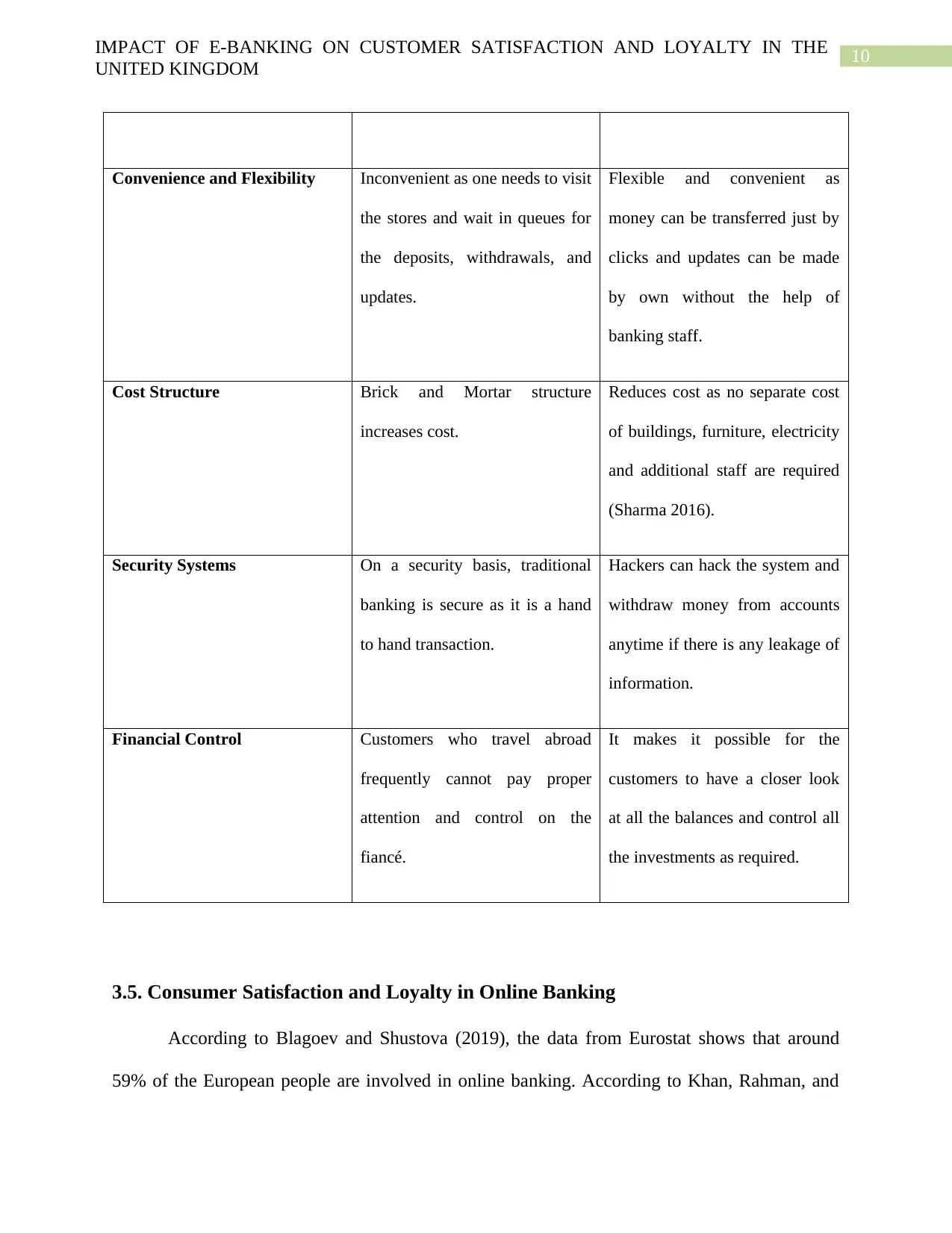
10IMPACT OF E-BANKING ON CUSTOMER SATISFACTION AND LOYALTY IN THE
UNITED KINGDOM
Convenience and Flexibility Inconvenient as one needs to visit
the stores and wait in queues for
the deposits, withdrawals, and
updates.
Flexible and convenient as
money can be transferred just by
clicks and updates can be made
by own without the help of
banking staff.
Cost Structure Brick and Mortar structure
increases cost.
Reduces cost as no separate cost
of buildings, furniture, electricity
and additional staff are required
(Sharma 2016).
Security Systems On a security basis, traditional
banking is secure as it is a hand
to hand transaction.
Hackers can hack the system and
withdraw money from accounts
anytime if there is any leakage of
information.
Financial Control Customers who travel abroad
frequently cannot pay proper
attention and control on the
fiancé.
It makes it possible for the
customers to have a closer look
at all the balances and control all
the investments as required.
3.5. Consumer Satisfaction and Loyalty in Online Banking
According to Blagoev and Shustova (2019), the data from Eurostat shows that around
59% of the European people are involved in online banking. According to Khan, Rahman, and
UNITED KINGDOM
Convenience and Flexibility Inconvenient as one needs to visit
the stores and wait in queues for
the deposits, withdrawals, and
updates.
Flexible and convenient as
money can be transferred just by
clicks and updates can be made
by own without the help of
banking staff.
Cost Structure Brick and Mortar structure
increases cost.
Reduces cost as no separate cost
of buildings, furniture, electricity
and additional staff are required
(Sharma 2016).
Security Systems On a security basis, traditional
banking is secure as it is a hand
to hand transaction.
Hackers can hack the system and
withdraw money from accounts
anytime if there is any leakage of
information.
Financial Control Customers who travel abroad
frequently cannot pay proper
attention and control on the
fiancé.
It makes it possible for the
customers to have a closer look
at all the balances and control all
the investments as required.
3.5. Consumer Satisfaction and Loyalty in Online Banking
According to Blagoev and Shustova (2019), the data from Eurostat shows that around
59% of the European people are involved in online banking. According to Khan, Rahman, and
Paraphrase This Document
Need a fresh take? Get an instant paraphrase of this document with our AI Paraphraser
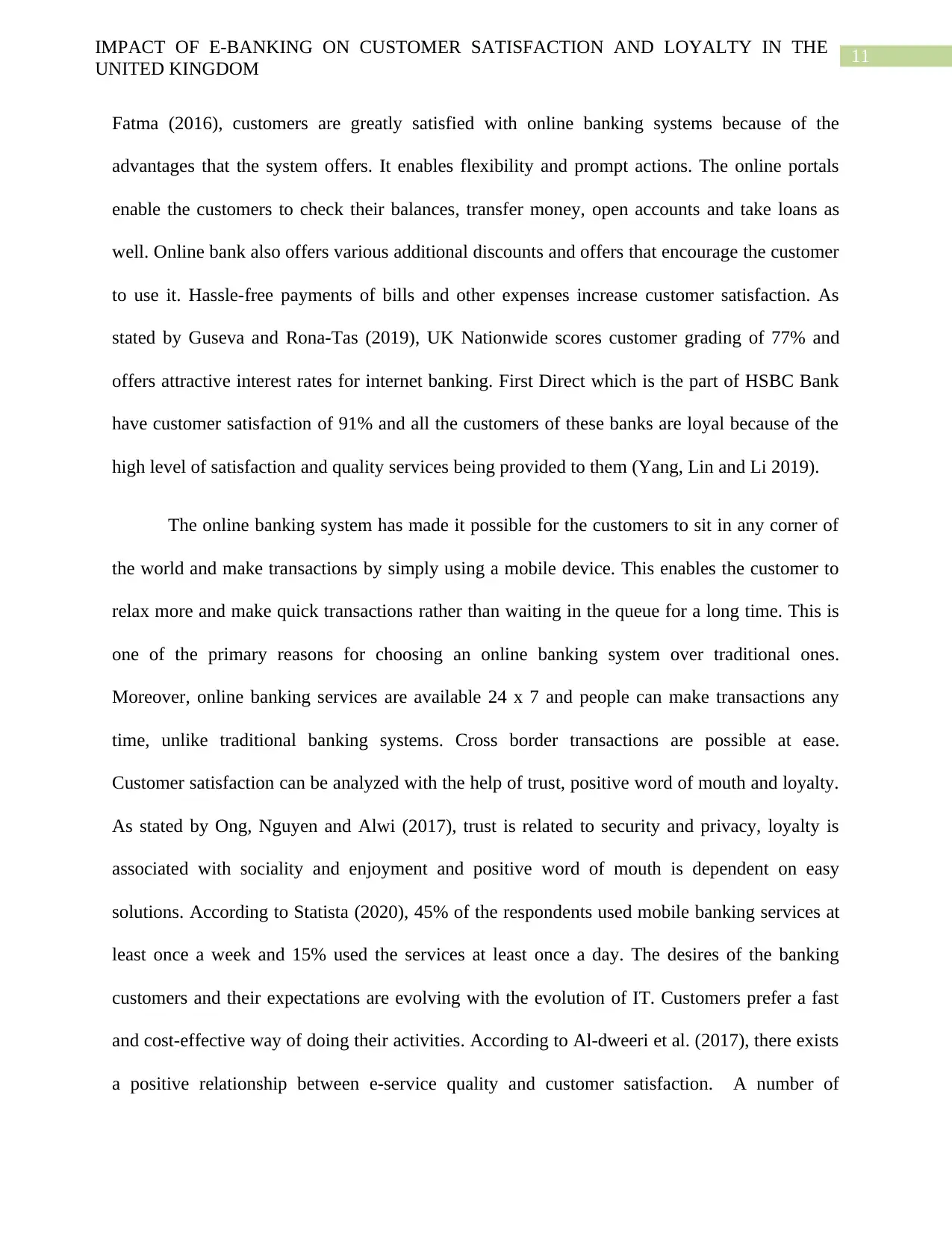
11IMPACT OF E-BANKING ON CUSTOMER SATISFACTION AND LOYALTY IN THE
UNITED KINGDOM
Fatma (2016), customers are greatly satisfied with online banking systems because of the
advantages that the system offers. It enables flexibility and prompt actions. The online portals
enable the customers to check their balances, transfer money, open accounts and take loans as
well. Online bank also offers various additional discounts and offers that encourage the customer
to use it. Hassle-free payments of bills and other expenses increase customer satisfaction. As
stated by Guseva and Rona-Tas (2019), UK Nationwide scores customer grading of 77% and
offers attractive interest rates for internet banking. First Direct which is the part of HSBC Bank
have customer satisfaction of 91% and all the customers of these banks are loyal because of the
high level of satisfaction and quality services being provided to them (Yang, Lin and Li 2019).
The online banking system has made it possible for the customers to sit in any corner of
the world and make transactions by simply using a mobile device. This enables the customer to
relax more and make quick transactions rather than waiting in the queue for a long time. This is
one of the primary reasons for choosing an online banking system over traditional ones.
Moreover, online banking services are available 24 x 7 and people can make transactions any
time, unlike traditional banking systems. Cross border transactions are possible at ease.
Customer satisfaction can be analyzed with the help of trust, positive word of mouth and loyalty.
As stated by Ong, Nguyen and Alwi (2017), trust is related to security and privacy, loyalty is
associated with sociality and enjoyment and positive word of mouth is dependent on easy
solutions. According to Statista (2020), 45% of the respondents used mobile banking services at
least once a week and 15% used the services at least once a day. The desires of the banking
customers and their expectations are evolving with the evolution of IT. Customers prefer a fast
and cost-effective way of doing their activities. According to Al-dweeri et al. (2017), there exists
a positive relationship between e-service quality and customer satisfaction. A number of
UNITED KINGDOM
Fatma (2016), customers are greatly satisfied with online banking systems because of the
advantages that the system offers. It enables flexibility and prompt actions. The online portals
enable the customers to check their balances, transfer money, open accounts and take loans as
well. Online bank also offers various additional discounts and offers that encourage the customer
to use it. Hassle-free payments of bills and other expenses increase customer satisfaction. As
stated by Guseva and Rona-Tas (2019), UK Nationwide scores customer grading of 77% and
offers attractive interest rates for internet banking. First Direct which is the part of HSBC Bank
have customer satisfaction of 91% and all the customers of these banks are loyal because of the
high level of satisfaction and quality services being provided to them (Yang, Lin and Li 2019).
The online banking system has made it possible for the customers to sit in any corner of
the world and make transactions by simply using a mobile device. This enables the customer to
relax more and make quick transactions rather than waiting in the queue for a long time. This is
one of the primary reasons for choosing an online banking system over traditional ones.
Moreover, online banking services are available 24 x 7 and people can make transactions any
time, unlike traditional banking systems. Cross border transactions are possible at ease.
Customer satisfaction can be analyzed with the help of trust, positive word of mouth and loyalty.
As stated by Ong, Nguyen and Alwi (2017), trust is related to security and privacy, loyalty is
associated with sociality and enjoyment and positive word of mouth is dependent on easy
solutions. According to Statista (2020), 45% of the respondents used mobile banking services at
least once a week and 15% used the services at least once a day. The desires of the banking
customers and their expectations are evolving with the evolution of IT. Customers prefer a fast
and cost-effective way of doing their activities. According to Al-dweeri et al. (2017), there exists
a positive relationship between e-service quality and customer satisfaction. A number of
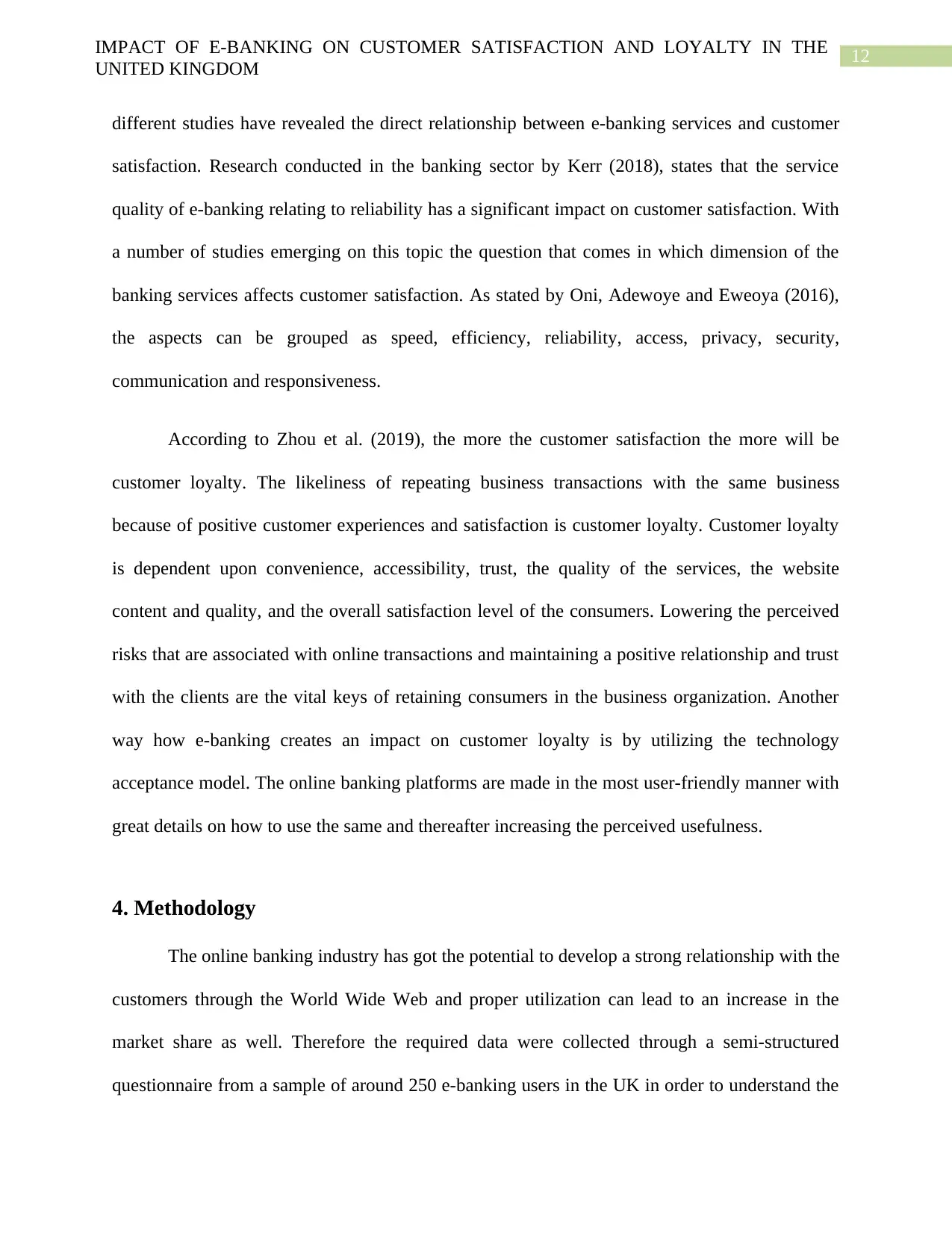
12IMPACT OF E-BANKING ON CUSTOMER SATISFACTION AND LOYALTY IN THE
UNITED KINGDOM
different studies have revealed the direct relationship between e-banking services and customer
satisfaction. Research conducted in the banking sector by Kerr (2018), states that the service
quality of e-banking relating to reliability has a significant impact on customer satisfaction. With
a number of studies emerging on this topic the question that comes in which dimension of the
banking services affects customer satisfaction. As stated by Oni, Adewoye and Eweoya (2016),
the aspects can be grouped as speed, efficiency, reliability, access, privacy, security,
communication and responsiveness.
According to Zhou et al. (2019), the more the customer satisfaction the more will be
customer loyalty. The likeliness of repeating business transactions with the same business
because of positive customer experiences and satisfaction is customer loyalty. Customer loyalty
is dependent upon convenience, accessibility, trust, the quality of the services, the website
content and quality, and the overall satisfaction level of the consumers. Lowering the perceived
risks that are associated with online transactions and maintaining a positive relationship and trust
with the clients are the vital keys of retaining consumers in the business organization. Another
way how e-banking creates an impact on customer loyalty is by utilizing the technology
acceptance model. The online banking platforms are made in the most user-friendly manner with
great details on how to use the same and thereafter increasing the perceived usefulness.
4. Methodology
The online banking industry has got the potential to develop a strong relationship with the
customers through the World Wide Web and proper utilization can lead to an increase in the
market share as well. Therefore the required data were collected through a semi-structured
questionnaire from a sample of around 250 e-banking users in the UK in order to understand the
UNITED KINGDOM
different studies have revealed the direct relationship between e-banking services and customer
satisfaction. Research conducted in the banking sector by Kerr (2018), states that the service
quality of e-banking relating to reliability has a significant impact on customer satisfaction. With
a number of studies emerging on this topic the question that comes in which dimension of the
banking services affects customer satisfaction. As stated by Oni, Adewoye and Eweoya (2016),
the aspects can be grouped as speed, efficiency, reliability, access, privacy, security,
communication and responsiveness.
According to Zhou et al. (2019), the more the customer satisfaction the more will be
customer loyalty. The likeliness of repeating business transactions with the same business
because of positive customer experiences and satisfaction is customer loyalty. Customer loyalty
is dependent upon convenience, accessibility, trust, the quality of the services, the website
content and quality, and the overall satisfaction level of the consumers. Lowering the perceived
risks that are associated with online transactions and maintaining a positive relationship and trust
with the clients are the vital keys of retaining consumers in the business organization. Another
way how e-banking creates an impact on customer loyalty is by utilizing the technology
acceptance model. The online banking platforms are made in the most user-friendly manner with
great details on how to use the same and thereafter increasing the perceived usefulness.
4. Methodology
The online banking industry has got the potential to develop a strong relationship with the
customers through the World Wide Web and proper utilization can lead to an increase in the
market share as well. Therefore the required data were collected through a semi-structured
questionnaire from a sample of around 250 e-banking users in the UK in order to understand the
⊘ This is a preview!⊘
Do you want full access?
Subscribe today to unlock all pages.

Trusted by 1+ million students worldwide
1 out of 18
Related Documents
Your All-in-One AI-Powered Toolkit for Academic Success.
+13062052269
info@desklib.com
Available 24*7 on WhatsApp / Email
![[object Object]](/_next/static/media/star-bottom.7253800d.svg)
Unlock your academic potential
Copyright © 2020–2025 A2Z Services. All Rights Reserved. Developed and managed by ZUCOL.




